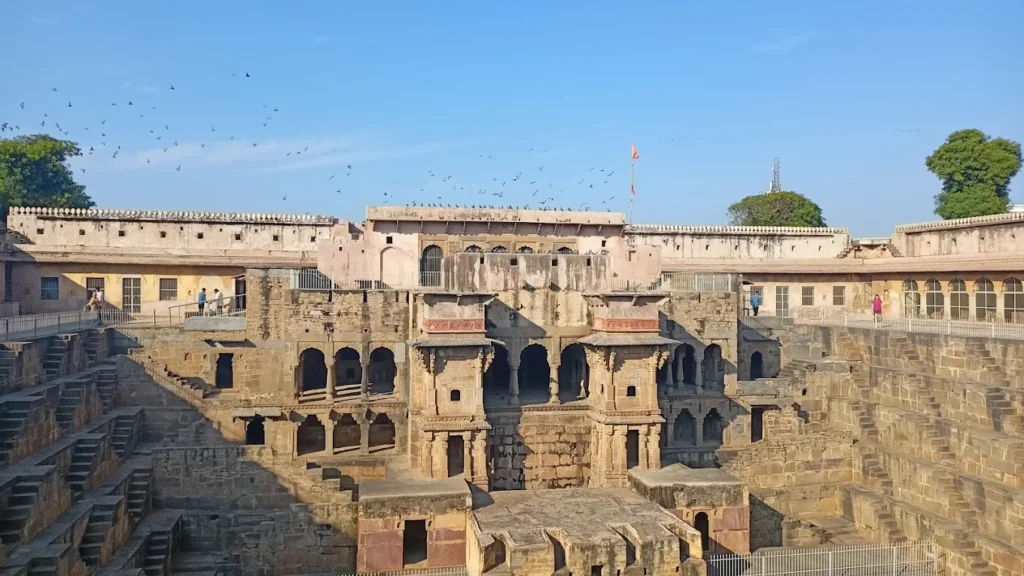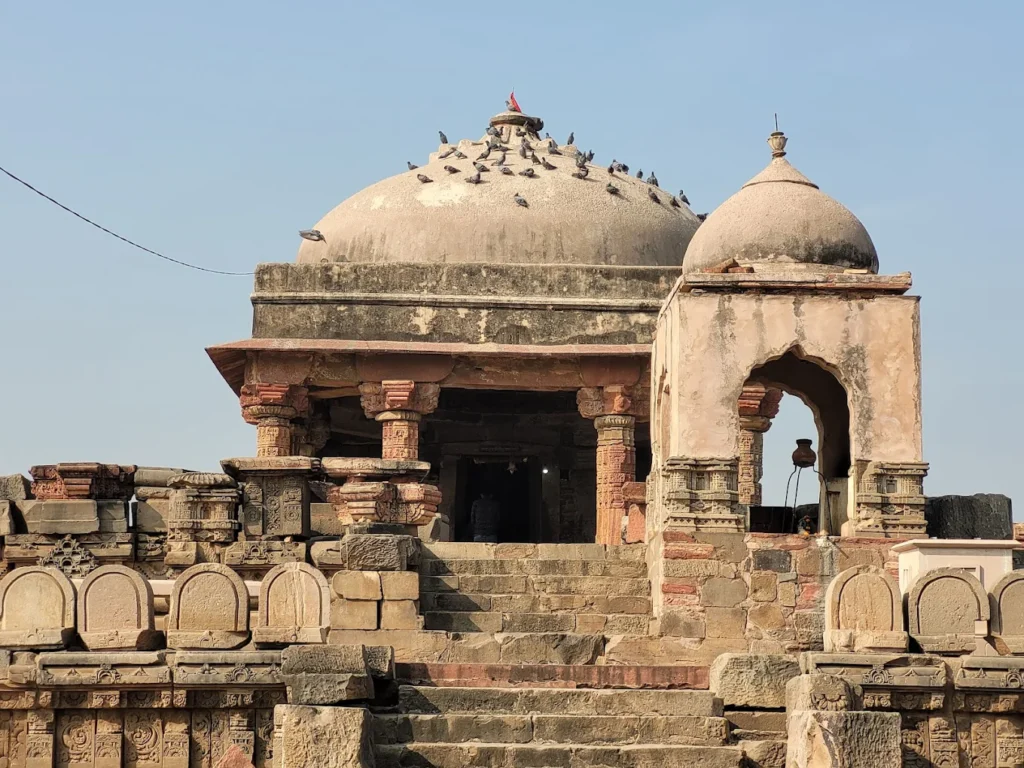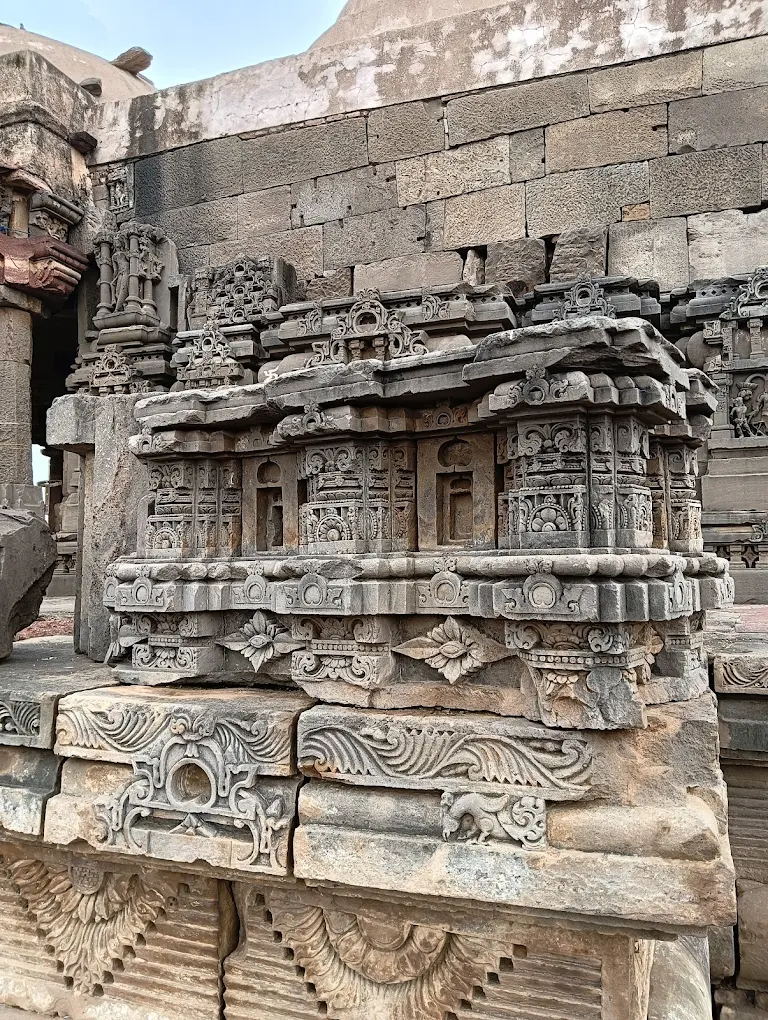The Harshat Mata Temple, also known locally as Harshad Mata Mandir, is one of the most revered and historically significant temples in Rajasthan. Situated in the quiet village of Abhaneri in Dausa district, the temple stands right beside the world-famous Chand Baori stepwell, making the duo one of the most visited heritage attractions near Jaipur.

Dedicated to Harshat Mata, the goddess of joy and happiness, the temple reflects the deep spiritual beliefs of the locals who consider the deity as the bringer of prosperity and well-being. Though much of the structure today lies in ruins due to invasions in medieval times, the temple still preserves intricately carved pillars, walls, and stone sculptures that highlight the architectural excellence of the 9th–10th century.
For travelers exploring Jaipur or passing through the Jaipur–Agra highway, the Harshat Mata Temple offers a unique blend of spiritual devotion, history, and art, making it an unmissable stop in Rajasthan.
Harshat Mata Temple Abhaneri – Dedicated to Which God?
The Harshat Mata Temple in Abhaneri is dedicated to Harshat Mata, revered as the goddess of joy, happiness, and prosperity. In local traditions, she is believed to be a manifestation of Maa Durga, bringing light, hope, and blessings to her devotees.
The villagers of Abhaneri and nearby areas hold strong faith in the goddess, believing that her divine grace ensures well-being, abundance, and peace in their lives. Historically, water from the nearby Chand Baori stepwell was considered sacred and often used in religious rituals performed in the temple.

Even though the temple today exists partly in ruins, the sanctum and surviving carvings still reflect its sacred essence. Devotees and visitors alike experience a sense of serenity when stepping into the temple premises, connecting with the spiritual aura of Harshat Mata.
History of Harshat Mata Temple
The Harshat Mata Temple in Abhaneri traces its origins back to the 9th–10th century, during the rule of the Gurjara-Pratihara dynasty. This period is known for its flourishing art and architecture, and the temple stands as a testimony to that golden era.
Originally, the temple was a grand structure with richly carved walls, tall pillars, and intricate sculptures depicting deities, celestial beings, and mythological stories. It is believed that King Chanda of the Nikumbha dynasty, who also commissioned the nearby Chand Baori stepwell, patronized the construction of the temple. Together, the temple and stepwell became the heart of Abhaneri village, serving both spiritual and social needs.
Unfortunately, the temple was heavily damaged during medieval invasions. What remains today are ruins and fragments of sculptures, but they still reflect the artistry of its creators. The Archaeological Survey of India (ASI) now maintains the site, preserving its remnants for cultural and historical study.
Despite its ruined state, the temple continues to be a place of worship, with villagers offering prayers to Harshat Mata, keeping alive centuries-old traditions.
Architecture & Archaeological Remains of Harshat Mata Temple
The Harshat Mata Temple may stand in ruins today, but its surviving elements provide a fascinating glimpse into the glorious temple architecture of the 9th–10th century.

Architectural Style
The temple was originally built in the North Indian (Nagara) style, characterized by its tall shikhara (spire), mandapa (pillared hall), and intricate carvings. Though the main shikhara has collapsed, the base and surrounding structures still reflect the grandeur it once held.
Carvings & Sculptures
- Pillars and walls are adorned with detailed stone carvings of gods, goddesses, apsaras, and celestial beings.
- Fragments of sculptures scattered around the temple complex showcase fine craftsmanship, particularly figures of Vishnu, Durga, and other deities.
- Some sculptures also depict mythological tales and symbolic motifs, highlighting the temple’s spiritual importance.
Archaeological Remains
The Archaeological Survey of India (ASI) has preserved and cataloged several remains, ensuring they stay protected for cultural and historical study. These include broken pillars, decorated panels, and deity idols, offering visitors a glimpse into the temple’s lost magnificence.
Despite its ruined state, the temple continues to attract historians, architects, and spiritual seekers, who come to admire its heritage and feel its divine aura.
Harshat Mata Temple and Chand Baori Connection
The Harshat Mata Temple and Chand Baori stepwell in Abhaneri are not just neighbors—they are deeply interconnected, both historically and culturally. Built around the 9th century, these two structures reflect the vision of the rulers who understood the importance of combining spirituality and practicality.
Sacred Connection
The temple, dedicated to Harshat Mata, the goddess of joy, was believed to draw divine energy that blessed the village. The nearby Chand Baori stepwell served as the main water source, and its water was often considered sacred, used for temple rituals and daily worship.
Cultural Center
Together, the temple and the stepwell became the heart of village life. While the stepwell provided water and a cool retreat during Rajasthan’s harsh summers, the temple offered a place for prayer, festivals, and spiritual gatherings.
Attraction for Visitors
Even today, most tourists who visit Chand Baori also explore the Harshat Mata Temple, making the duo a combined heritage experience. The temple adds spiritual depth to the architectural marvel of the stepwell.
Distance & How to Reach Harshat Mata Temple Abhaneri
The Harshat Mata Temple is located (Google Maps) in Abhaneri village, Dausa district, Rajasthan, right beside the famous Chand Baori stepwell. Its central location on the Jaipur–Agra route makes it an easily accessible heritage site.
Distance from Major Cities
- Jaipur to Harshat Mata Temple: ~95 km (approx. 2 hours by road)
- Agra to Harshat Mata Temple: ~165 km (approx. 3.5 hours by road)
- Delhi to Harshat Mata Temple: ~260 km (approx. 5–6 hours by road)
How to Reach
- By Road: The most convenient way is via NH21 (Jaipur–Agra highway). Cabs, taxis, and private vehicles can easily reach the site.
- By Train: The nearest railway station is Bandikui Junction, about 8 km from Abhaneri, well connected to Jaipur and Delhi.
- By Air: The closest airport is Jaipur International Airport, around 90 km away.
Travel Directions
Visitors often combine the Harshat Mata Temple and Chand Baori as part of a day trip from Jaipur or while traveling between Jaipur and Agra. Local guides are available to share the temple’s history and legends.
Harshat Mata Temple Timings & Visitor Information
The Harshat Mata Temple in Abhaneri welcomes visitors throughout the week, allowing devotees and tourists to experience its spiritual and historical significance.
Timings
- Opening Time: 6:00 AM
- Closing Time: 6:00 PM
- Days Open: All days of the week (daily)
These timings make it convenient for travelers visiting the nearby Chand Baori stepwell, as both can be explored together in the same trip.
Photography & Exploration
- Photography is allowed, and the carved stone remains and temple backdrop make for wonderful cultural captures.
- Visitors often combine photos of Harshat Mata Temple and Chand Baori, showcasing the heritage duo of Abhaneri.
Visitor Tips
- The best time to visit is during the winter months (October–March) for pleasant weather.
- Arrive early in the morning or late afternoon to enjoy the serene atmosphere with fewer crowds.
- Wear comfortable footwear, as the temple grounds and stepwell steps involve some walking.
The temple may be partly in ruins, but its spiritual aura and historical richness continue to draw devotees and travelers alike.
Nearby Attractions Around Harshat Mata Temple
A visit to the Harshat Mata Temple is often combined with nearby sites, giving travelers a richer cultural and historical experience in Abhaneri.
Chand Baori Stepwell
Right next to the temple lies the world-famous Chand Baori, one of the largest and deepest stepwells in the world, with over 3,500 steps across 13 levels. It was built around the same time as the temple and served as a vital water source for rituals and daily life.
Abhaneri Village
The village of Abhaneri offers a chance to witness rural Rajasthan’s lifestyle. From mud houses to traditional farming practices and handicrafts, the village reflects the cultural essence of the region.
Local Festivals & Fairs
The area often hosts small village fairs and religious gatherings, especially during festivals like Navratri, when locals celebrate Harshat Mata with devotion and rituals.
En Route Attractions
Since the temple lies on the Jaipur–Agra highway, visitors can also combine their trip with stops at:
- Dausa town for local food and markets.
- Bhandarej Baori, another stepwell showcasing Rajasthan’s water architecture.
Together, these attractions make the Harshat Mata Temple trip more than just a spiritual visit, it becomes a complete heritage experience.
Best Time to Visit Harshat Mata Temple
The experience of visiting the Harshat Mata Temple can vary greatly depending on the season and time of day. To truly enjoy its serenity and heritage charm, planning your visit wisely is important.
Seasonal Best Time
- October to March (Winter): The most pleasant season, with cool weather (10°C–25°C). Ideal for sightseeing and photography.
- April to June (Summer): The region can get extremely hot, with temperatures soaring above 40°C. Early morning visits are recommended if traveling during summer.
- July to September (Monsoon): Light to moderate rains bring greenery to the surroundings, but pathways may get slippery.
Time of Day
- Morning (6:00 AM – 9:00 AM): Peaceful atmosphere with fewer visitors, perfect for meditation and photography.
- Late Afternoon (4:00 PM – 6:00 PM): Cooler weather and soft golden light make the temple and nearby stepwell look enchanting.
For the best experience, plan your trip during winter mornings or evenings, when both the temple and Chand Baori stepwell can be explored comfortably.
FAQ about Harshat Mata Temple
Where is Harshat Mata Temple located?
The Harshat Mata Temple is located in Abhaneri village, Dausa district, Rajasthan, right next to the famous Chand Baori stepwell, about 95 km from Jaipur.
Harshat Mata Temple Abhaneri is dedicated to which god?
The temple is dedicated to Harshat Mata, believed to be a form of Goddess Durga, worshipped as the goddess of joy, happiness, and prosperity.
What is the history of Harshat Mata Temple?
The temple was built in the 9th–10th century during the Gurjara-Pratihara dynasty. It was once a grand structure but now remains partially in ruins due to medieval invasions.
What can visitors see at Harshat Mata Temple today?
Visitors can explore intricate carvings, sculpted pillars, and archaeological remains that reflect the temple’s original grandeur. Despite its ruined state, it remains an active site of worship.
What are the timings of Harshat Mata Temple?
The temple is open daily from 6:00 AM to 6:00 PM, making it easy for travelers to visit alongside Chand Baori.
How far is Harshat Mata Temple from Jaipur?
The temple is around 95 km from Jaipur (approx. 2 hours by road). The nearest railway station is Bandikui Junction (8 km), and the nearest airport is Jaipur International Airport (90 km).
Is Harshat Mata Temple connected to Chand Baori?
Yes, the temple and Chand Baori are closely linked. Water from the stepwell was traditionally used for temple rituals, symbolizing the connection between faith and utility in ancient times.
What is the best time to visit Harshat Mata Temple?
The best season is October to March when the weather is pleasant. The ideal time of day is early morning or late afternoon for a peaceful and comfortable visit.
The Harshat Mata Temple in Abhaneri is more than just a religious site, it is a living piece of Rajasthan’s heritage, blending spirituality, history, and architecture. Dedicated to Harshat Mata, the goddess of joy and happiness, the temple has been a center of devotion for centuries, standing alongside the magnificent Chand Baori stepwell.
Though parts of the temple lie in ruins due to invasions, the surviving stone carvings, pillars, and sculptures still showcase the artistic brilliance of the 9th–10th century Gurjara-Pratihara dynasty. Its connection with Chand Baori highlights how faith and utility were harmoniously interwoven in ancient Indian society.
For travelers, the temple offers a serene spiritual experience, a chance to admire archaeological remains, and a gateway into Abhaneri’s cultural life. Whether you are a devotee, a history enthusiast, or a curious explorer, the Harshat Mata Temple is a destination that leaves you with a sense of peace and wonder.
